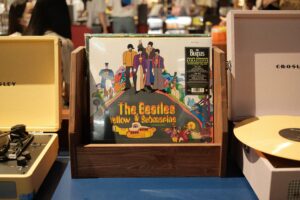Latin music is a genre of music that originates from Latin America and includes a wide range of musical styles and rhythms, such as salsa, samba, merengue, cumbia, reggaeton, and bachata. Latin music has strong influences from African, European, and Indigenous cultures, which have blended together to create a diverse and vibrant musical tradition.
Latin music has gained popularity around the world and has become a staple of many music festivals and events. It is known for its infectious rhythms and lively beats, and often incorporates complex percussion, brass and string instruments, and expressive vocals. Latin music is not only enjoyed for its upbeat and danceable tunes, but also for its emotional and lyrical depth, which often reflects themes of love, social justice, and cultural identity.

There are many examples of Latin music, as the genre encompasses a wide range of styles and rhythms. Here are some popular examples:
-
Salsa: “Oye Como Va” by Tito Puente, “La Vida es un Carnaval” by Celia Cruz, “Pedro Navaja” by Ruben Blades
-
Reggaeton: “Gasolina” by Daddy Yankee, “Dile” by Don Omar, “Despacito” by Luis Fonsi and Daddy Yankee
-
Merengue: “Suavemente” by Elvis Crespo, “Ojitos Chinos” by Gran Combo de Puerto Rico, “La Dueña del Swing” by Los Hermanos Rosario
-
Bachata: “Obsesión” by Aventura, “Propuesta Indecente” by Romeo Santos, “Burbujas de Amor” by Juan Luis Guerra
-
Cumbia: “La Pollera Colorá” by Wilson Choperena, “Cumbia Sobre el Río” by Celso Piña, “La Colegiala” by Rodolfo Aicardi
-
Bossa Nova: “The Girl from Ipanema” by João Gilberto and Stan Getz, “Corcovado” by Antonio Carlos Jobim, “Wave” by Tom Jobim
Design can play a significant role in Latin music, as it can be used to create visual elements that complement and enhance the music itself. Here are some examples of how design can be part of Latin music:
-
Album artwork: Just like any other genre of music, Latin music artists often create unique album artwork to represent their music and identity. Album artwork can range from simple designs featuring the artist’s photo, to more elaborate and intricate designs that incorporate elements of Latin American culture and art.
-
Concert posters and flyers: Concert posters and flyers are often used to promote upcoming shows and events. In Latin music, these designs can incorporate bright colors, bold typography, and traditional Latin American imagery, such as Aztec or Mayan motifs, to create a visually striking and memorable design.
-
Music videos: Music videos are a popular medium for promoting music and can be used to create visual representations of the music and lyrics. In Latin music, music videos often incorporate vibrant colors, traditional dances, and cultural references to showcase the music’s roots and identity.
-
Merchandise: Merchandise, such as t-shirts, hats, and posters, can feature designs that reflect the artist’s identity and music. In Latin music, merchandise designs can incorporate traditional Latin American patterns, images of iconic musicians, or lyrics from popular songs.
Overall, design can be an essential part of Latin music by creating visual elements that complement and enhance the music’s identity and cultural roots.

These are just a few examples of the many different styles of Latin music that exist.
Latin music has become increasingly popular in North America in recent years, with many Latin American artists achieving mainstream success and recognition. In the United States, Latin music has been embraced by a diverse audience, including Latinx communities, as well as fans of pop, hip-hop, and other genres. Some examples of Latin music’s impact in North America include:
-
In 2017, the Spanish-language song “Despacito” by Luis Fonsi and Daddy Yankee became a global hit and broke several records, including being the first Spanish-language song to top the Billboard Hot 100 chart in over 20 years.
-
The Latin Grammy Awards, which recognize excellence in Latin music, have been held in the United States since 2000, and have helped to promote Latin music and its artists to a wider audience.
-
Major music festivals, such as Coachella and Lollapalooza, have included more Latin music acts in their lineups in recent years, reflecting the growing popularity of the genre.
-
Latinx artists, such as Shakira, Jennifer Lopez, and Bad Bunny, have achieved mainstream success in North America, with chart-topping songs and sold-out concerts.
Overall, Latin music has become an integral part of the North American music landscape, reflecting the diversity and vibrancy of the Latinx communities and their cultural contributions.